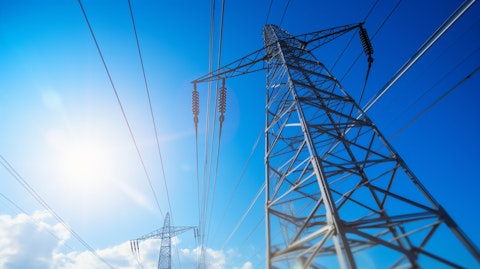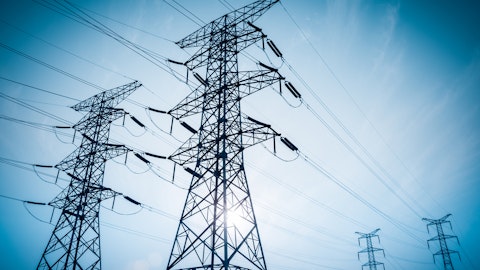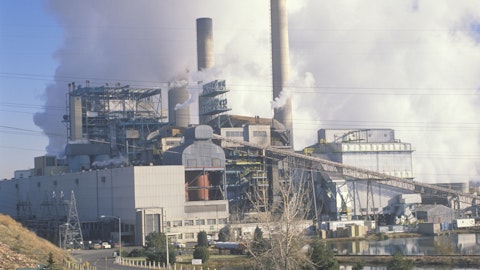Alliant Energy Corporation (NASDAQ:LNT) Q3 2023 Earnings Call Transcript November 3, 2023
Operator: Thank you for holding, and welcome to Alliant Energy’s Third Quarter 2023 Earnings Conference Call. At this time, all lines are in listen-only mode. Today’s conference call is being recorded. I would now like to turn the call over to your host, Susan Gille, Investor Relations Manager at Alliant Energy.
Susan Gille: Good morning. I would like to thank all of you on the call and the webcast for joining us today. We appreciate your participation. With me here today are John Larsen, Chair and CEO; Lisa Barton, President and COO, and Robert Durian, Executive Vice President and CFO. Following prepared remarks by John, Lisa and Robert, we will have time to take questions from the investment community. We issued a news release last night announcing Alliant Energy’s third quarter and year-to-date financial results, narrowed our 2023 earnings guidance range, provided 2024 earnings and dividend guidance, and provided our annual capital expenditure plan through 2027. This release as well as earnings presentation will be referenced during today’s call and is available on the Investor page of our website at www.alliantenergy.com.
Before we begin, I need to remind you the remarks we make on this call and our answers to your questions include forward-looking statements. These forward-looking statements are subject to risks that could cause actual results to be materially different. Those risks include, among others, matters discussed in Alliant Energy’s news release issued last night and in our filings with the Securities and Exchange Commission. We disclaim any obligation to update these forward-looking statements. In addition, this presentation contains references to non-GAAP financial measures. The reconciliation between non-GAAP and GAAP measures are provided in the earnings release and our quarterly report on Form 10-Q, which is available on our website. At this point, I’ll turn the call over to John.
John Larsen: Thank you, Susan. Good morning, everyone, and thank you for joining us today. I’m pleased to report that we are firmly on track for delivering another year of solid financial and operating results. Consequently, we are narrowing our 2023 earnings guidance range, and I am affirming our long-term earnings growth range of 5% to 7%. We take great satisfaction in consistently achieving our earnings growth objectives. Continuing that momentum, turning to 2024, I’m pleased to share our earnings guidance and dividend target. Our 2024 earnings guidance midpoint represents a 6% increase to our forecasted 2023 adjusted earnings, and our 2024 annual common stock dividend target is $1.92 per share, which is a 6% increase from this year’s dividends.
We are focused on delivering steady and predictable results. We have several key headlines and highlights this quarter, but before I get to them, I’d like to touch on the news you likely saw last week. I’m incredibly honored to have been with Alliant Energy for the past 35 years, and I’m excited to be continuing that journey and moving into the role of Executive Chairman of our company, as Lisa Barton assumes the role of CEO. Lisa is an exceptional leader with a well-established track record of success. Together with the Board of Directors, I have complete confidence that she is well-positioned to further Alliant Energy’s ability to deliver consistent results as we continue to focus on our purpose of serving customers and building stronger communities.
Speaking of that purpose, let me take a few minutes to share a few headlines from quarter three that I’m particularly proud of. Then I’ll pass it over to Lisa and Robert to provide more details. The first headline centers on our strong core investment thesis. That is why you choose to invest in our company. Simply put, we consistently deliver strong results. The well-executed, forward-thinking actions our team took to mitigate rising financing costs positions our company to deliver on investor expectations, coupled with our exceptional project execution and unwavering commitment to cost management and efficiency, makes us well-positioned to achieve our long-term earnings guidance objective for the 14th consecutive year. Our second headline highlights our updated customer-centric capital investment forecast through 2027, which increases our CapEx by almost $600 million compared to the four-year plan we announced last year.
Lisa will cover the details of these exciting investments later in the call. To build on my earlier comments, I continue to take immense pride in the work of our dedicated teams who have diligently navigated through challenging financial, procurement, and economic conditions. I’m especially pleased with our team’s efforts in taking advantage of the enhanced benefits from the Inflation Reduction Act. We are nearing completion of executing our contracts to monetize tax credits generated by our wind, solar, and energy storage investments. This helps us reduce our financing needs, create substantial cost savings for our customers, all while taking advantage of zero fuel cost resources and reducing our greenhouse gas emissions. Now let me highlight two innovative projects we are excited about.
First, we celebrated our first Iowa customer-hosted solar project, which is nearing completion near Ames, Iowa, and is expected to be operational in the first half of 2024. This solar farm at Iowa State University will serve as a one-of-a-kind setting to advance the concept of agrivoltaics. We are partnering with both Iowa State and the University of Wisconsin in this innovative area of research. Agrivoltaics research is intended to uncover how solar, agricultural land and farming can harmoniously coexist for mutual benefit. The second project is our long-duration storage project at the Columbia Energy Center near Portage, Wisconsin. A first-of-a-kind energy project in the United States, the 200 megawatt hour energy storage system will be built to deliver 10 hours of energy storage capacity by compressing carbon dioxide gas into liquid.
We are particularly excited this project will be built in the same community that has hosted our Columbia Energy Center for the last 40-plus years. Siting this project at an existing generating facility enables us to take advantage of the existing grid interconnection. Our company was selected for a $30 million grant from the US Department of Energy Office of Clean Energy to support this project. Importantly, both projects exemplify our purpose and showcases how our forward-thinking efforts, partnerships, and innovation are helping us build stronger communities. Our investments are made in our backyard, in the communities we serve, where our customers live, and where we partner with local suppliers, contractors, and vendors. Now, before I turn the call over to Lisa, I’d like to recognize that the farmers in our service territory are in the later stages of harvest season, and I’d like to extend my appreciation to all farmers and farm families for your commitment and partnership.
Together, we are using the Earth’s natural resources to provide vital services. Please be safe as you wrap up your harvest. And I’d also like to take a moment to reflect on the achievements of our dedicated employees as we conclude another strong quarter. They have done a tremendous job of serving our customers and positioning us for success. Their efforts to keep the lights on and the gas flowing irrespective of weather conditions underscores our unwavering commitment to our purpose. I will now turn the call over to Lisa.
Lisa Barton: Thank you, John. It is an honor to be entrusted with the future growth and stewardship of this industry-leading company. Since joining Alliant Energy, it has been abundantly clear that our organization lives and delivers on its purpose day in and day out. In fact, the organization’s commitments and alignment with its purpose is what drew me to Alliant Energy. I recently had the opportunity to meet with our team in Janesville, Wisconsin and was struck by the level of engagement and ideas our frontline teams brought to the table to better serve our customers. As you know, we are actively undergrounding our lines to provide greater reliability and system resiliency. In this conversation, our employees were offering suggestions to prioritize the undergrounding of overhead facilities located in backyards.
They were sharing how these facilities can be difficult to get to, require specialized equipment, and due to the nature of the terrain, restoration can be time-consuming, factors that can be avoided by undergrounding. I appreciated their ideas and focus on our customers with the goal to reduce outages and restoration times, a notable example of the level of engagement and the connection with our purpose to serve our customers and build stronger communities. Our team’s passion for innovation and dedication to serving our customers and communities is consistent across the company in both Iowa and Wisconsin. And it’s precisely why it is a true privilege to take on the role of CEO and to serve as a member of our Board of Directors. Before going into the CapEx plan, I would like to underscore our organization’s ongoing role of being at the forefront of the clean energy transition by providing our customers with access to a cleaner and more diverse energy mix.
In 2022, approximately 40% of the energy we supplied to retail customers was generated by zero-fuel-cost renewable resources. This number will quickly grow with the addition of 1.2 gigawatts of solar set to be in service by the end of 2024. Across our portfolio of new generation, we are successfully bringing projects online, investing in energy security, creating local jobs, and providing valuable tax revenues for the communities we serve. In Wisconsin, we expect to bring approximately 600 megawatts of solar online by year-end. In Iowa, with an advanced ratemaking ruling in hand for our planned 400 megawatts of solar, we will continue to expand our investments in resilient, clean energy resources for our customers and communities by bringing this new generation online.
In addition to solar, we made great strides in our energy storage plans during the third quarter. We commissioned our first microgrid project in Richland County. We secured regulatory approval in Wisconsin for 175 megawatts of battery storage projects in Wood and Grant counties, which will be paired with our solar investments. In addition, we secured approval for 99 megawatts of battery storage at our Edgewater Generating facility site to take advantage of our existing interconnection and additional tax credits associated with repurposing a brownfield site. These storage projects strengthen the performance of our generation portfolio, increase grid resiliency, and improve reliability. These investments tie to the capital expenditures John mentioned, which are essential to deliver a diverse mix of energy with the enhanced reliability our customers depend on.

Looking forward, we have refreshed our capital expenditures plan over the next four years by $600 million. These investments expand our dispatchable generation resources, include wind repowering for approximately 500 megawatts of our legacy wind fleet, bringing efficiency savings to our customers, and additional tax benefits through the Inflation Reduction Act. This plan reflects increased investments in American Transmission Company to support expansion of transmission within the state of Wisconsin, and underscores our commitment to enhancing grid resiliency and undergrounding. Our updated customer-centric capital investment forecast through 2027 contributes to a solid 8% rate-based growth through 2027. Approximately 55% of our investments over the next four years will be in generation, a strong demonstration of our commitment to a diverse, clean, reliable, and resilient energy future for our customers.
We take considerable pride in the balance of resources in our generation portfolio. We will continue to invest in renewables over the five-year planning period. We also recognize our resource plans need to address MISO’s resource adequacy needs. This is why you see greater additional capital expenditures for gas projects when compared to prior plans. In 2024, we will continue our transparent process to engage with regulators and stakeholders as we update and revise our resource plans to adapt to changing reliability needs. Our plans include new dispatchable natural gas resources, capacity and efficiency improvements, and investments to ensure resiliency and availability of fuels during extreme weather and other disruptions. Specifically, our focus will be on improving the capacity and efficiency of our existing units in both Iowa and Wisconsin as well as repurposing sites where coal units will be retiring in the next five years.
We will be investing in new flexible natural gas resources to complement our investments in battery storage and renewables. We will also invest in reliability of natural gas supply in both Iowa and Wisconsin to address concerns about reliability and resiliency during extreme weather. This includes exploring opportunities to enhance resiliency through gas LNG and electric storage technologies. Now switching to regulatory matters. First, we appreciate the certainty the IUB’s advanced ratemaking decision provides. Last month, the IUB approved a minimum ROE of 10.25% over the 30-year life of 400 megawatts of solar. We remain confident in the advanced ratemaking process and look forward to submitting additional filings following our stakeholder and regulatory engagement process next year.
Staying in Iowa, we recently filed our forward test year rate review. Our forward-looking electric and gas rate review focuses on our plans to strategically invest in a cost-effective and diverse energy mix coupled with grid modernization to deliver a more reliable, sustainable, resilient, and secure energy future for our Iowa customers and communities. With our steadfast focus on keeping customer value top of mind, we continuously strategize to take proactive measures to manage costs and to meet customers’ ever-changing energy needs. This is the reason why we have asked for a two-step increase. The investments we are making in the state are expected to reduce the number and duration of outages, improve safety, lower operating, maintenance, and fuel expenses while reducing the impact of fuel price volatility.
Shifting gears to our rate review in Wisconsin, the procedural schedule is now complete, and we await a decision from the PSCW to place new rates into effect on January 1st. We believe the PSCW staff testimony was constructive and gave the commission a good starting point for their decision. I will now turn the call over to Robert to provide insights regarding our financial results, guidance, and a few additional regulatory matters.
Robert Durian: Thanks, Lisa. Good morning, everyone. Yesterday, we announced third quarter non-GAAP earnings of $1.05 per share compared to $0.93 per share in the second — or third quarter of 2022. Our quarterly earnings change year-over-year was primarily due to higher revenue requirements and AFUDC from WPL capital investments and lower operating and maintenance expenses. These positive drivers were partially offset by higher interest expense. The non-GAAP adjustment recorded in the third quarter of $0.03 per share related to Iowa state tax reform. In September, the Iowa Department of Revenue announced a corporate state tax rate of 7.1% for 2024, which is down from the current rate of 8.4%. This change resulted in a current year charge at our non-utility and parent operations related to lower deferred tax asset values.
This change will also enable us to pass millions of dollars of annual savings from lower state taxes onto our customers in Iowa for decades into the future. A similar non-GAAP adjustment was recognized in the third quarter last year related to Iowa’s corporate tax rate change effective for 2023. Through September of this year, our net temperature impacts decreased Alliant Energy’s earnings by approximately $0.02 per share. In comparison, net temperatures increased Alliant Energy earnings for the first three quarters of 2022 by $0.07 per share. Our temperature-normalized electric sales through the first three quarters are tracking in line with sales for the same period in 2022, including no material changes across the customer classes or our two states.
Looking forward to the fourth quarter and our full-year 2023 results, we expect strong earnings growth from investments in Wisconsin and Iowa solar projects and lower O&M, partially offset by higher interest expense. As a result of solid earnings through September and our projected fourth quarter results, we have narrowed our 2023 earnings guidance to a range of $2.85 per share to $2.93 per share. During 2023, our team has continued to advance our purpose-driven strategy to ensure that we not only accomplish our current year goals, but also enable the achievement of our financial and operational objectives over the long term. We strategically invest in the best interest of our customers, aiming to enhance customer value while controlling customer costs.
As we continue our transition to renewables while preparing to retire our fossil fuel generating resources, we will continue to reduce our operating costs. Additionally, with the implementation of our planned solar projects and the repowering of our wind facilities, we anticipate the production tax credits and reduced fuel expenses will help offset the impact of increased renewable rate base, rendering these new investments highly cost-effective for our customers. This commitment will result in long-term benefits for our customers and long-term value for our shareowners. With our success thus far in advancing and executing on our renewable capital projects, we continue to be well-positioned to capture additional benefits of the Inflation Reduction Act.
Expected benefits include applying for federal funding, maximizing tax benefits by meeting tax credit adder requirements, and leveraging new and enhanced opportunities to monetize tax credits, which materially improve our cash flows and credit metrics as well as reduce future financing needs. Moving to our financing plans, in September, we successfully completed a $300 million debt issuance at IPL to finance our solar generation projects. And so far this year, we have issued approximately $200 million of new common equity. Thus, we are well on our way to raising our planned $250 million in equity for 2023. As we look to future financings, our robust capital investment plan is expected to be financed through a combination of cash from operations including significant proceeds from tax credit monetizations and new long-term debt.
We also have modest levels of common equity anticipated in our financing plans through 2027. Including approximately $25 million of new common equity plan each year from our Shareowner Direct Plan. And up to $350 million of new common equity in aggregate through future ATM programs. The new common equity through future ATM programs is largely dependent upon whether the PSCW and IUB granted authority of our request to increase the equity layers in WPL’s and IPL’s capital structures in their respective pending rate reviews. More near-term, our plans over the next 14 months include up to $1.9 billion of financing, including up to $1 billion of long-term debt at Alliant Energy Finance, up to $700 million of debt at IPL, approximately $25 million of new Common equities through our Shareowner Direct Plan direct plan and up to $200 million of new common equity, only to support any increase authorized by the PSCW for WPL’s equity layer.
We also have two debt maturities in 2024, including $450 million at Alliant Energy Finance and $500 million at IPL. Finally, I’ll highlight our regulatory initiatives in progress, as well as those regulatory filings we plan to initiate in 2024. Currently, in progress, we have electric and gas rate reviews in each state. In Wisconsin, we anticipate an oral decision before Thanksgiving and a written order by the end of December. And in Iowa, we expect a decision by the third quarter of next year. We also have two additional pending proceedings in Wisconsin. We are anticipating a decision on our request for improvements aimed to increase the efficiency, capacity, and reliability of our Neenah and Sheboygan Falls’ gas-generating units by the end of Q2 2024.
In this quarter, we filed a joint application to sell an additional 125 megawatts of the West Riverside facility to WEC Energy and Madison Gas and Electric. We are also anticipating a decision on this application by Q2 of 2024. Turning to our planned regulatory filings in 2024, in conjunction with our updated capital expenditure plan, we expect to make regulatory filings in both Iowa and Wisconsin for additional renewables and dispatchable resources to enhance reliability, further diversify our energy resources, and meet customer energy needs. These filings will also include construction authority requests for the innovative new long-duration energy storage in Wisconsin mentioned by John. We very much appreciate the continued support of our company and look forward to meeting with many of you at the EEI Finance Conference.
Next week, we plan to post on our website the updated materials in advance of EEI. At this time, I’ll turn the call back over to the operator to facilitate the question-and-answer session.
Operator: Thank you, Mr. Durian. At this time, the company will open up the call to questions from members of the investment community. Ladies and gentlemen, we will now begin the question-and-answer session. [Operator Instructions] Your first question comes from Nicholas Campanella with Barclays. Please go ahead.
See also 15 Biggest Journalism Companies in the US and 20 Countries With Highest Tea Consumption Per Capita.
Q&A Session
Follow Alliant Energy Corp (NYSE:LNT)
Follow Alliant Energy Corp (NYSE:LNT)
Nathan Richardson: Hey, everybody. It’s actually Nathan Richardson on for Nick.
Lisa Barton: Hey, Nathan.
John Larsen: Good morning.
Nathan Richardson: Hello. Happy Friday. I just have a couple of questions here. You touched on the tax credit opportunity a little bit, and I appreciate the ’23 and ’24 guidance, but I was wondering if you could give any more Color into ’25 and ’26 and then maybe the full contribution over the five-year plan?
Robert Durian: Yes, Nathan, probably paint a little bit of a picture here for our financing plans. When we think about the capital expenditure refresh that we’ve done through 2027, and as we look at the kind of financing needs for that, we actually think that we’ll be able to fund all of that through cash flows from operations, including the monetization of tax credits, as well as some new long term debt. As we look at the opportunities to be able to monetize those tax credits, given the volume of tax credits we’re generating currently with the wind projects and the solar projects, as well as those that will be added into our portfolio over the next few years, along with battery storage, we actually think we’ll be averaging probably close to $300 million a year in tax credit monetization proceeds.
So that provides us a lot of flexibility with our financing plans and therefore does not require any material common equity to be able to finance those capital expenditure plans. Where we do see potentially some need for new common equity is largely related to the regulatory constructs, specifically the capital structures for our two utilities that is dependent upon the outcomes of the pending rate cases. So that’s to be determined, we should be seeing, hopefully, our WPL rate case decision here in the next couple of weeks. And as I indicated before, the Iowa decision, sometime probably by the second quarter, or third quarter of next year. And so that’ll give us more insights as to any potential equity needs, but it’s really tied into those additional equity layers at the two utilities.
Nathan Richardson: Got it. That’s super helpful. Thank you. And then my last question is some of your Midwest peers have been showing some decline in load in fiscal year ’23. And I just wanted to see how we could think about what you’ve embedded in the fiscal year ’24 outlook from a sales perspective and then maybe any longer term sales growth assumptions.
John Larsen: Hey, Nathan. This is John here. You know, ’23 has been largely in line with our expectations from temperature-normalized load, and we’re planning for that similarly going forward. But I would say we do have some pretty strong economic development interests. We’ve kept our forecast pretty conservative, pretty steady, as we’ve seen, but we’ve seen some great interest here. And when we see that materialize a bit more, we’ll provide updates if or as needed.
Nathan Richardson: Got it. Thank you so much.
John Larsen: You bet. Thank you.
Operator: Your next question comes from Julien Dumoulin Smith with Bank of America. Please go ahead.
Dariusz Lozny: Hey, good morning. This is Dariusz on for Julien. Thanks for taking the question. Just wanted to start off on the narrowed 2023 guidance. Thank you for providing that update. Just wondering if now that we’re in November and there’s probably good line of sight to the end of the year. If you can make any commentary as far as where you might be tracking within that range for the balance of the year.
Robert Durian: Yes, Dariusz, this is Robert. Yes, I would characterize that we’re tracking towards the midpoint. We have seen what I’d characterize, some milder weather temperatures in the first quarter this year. That really put our earnings down about $0.4 per share. But we actually picked up $0.2 back in the third quarter, given some warmer temperatures. And so far here in the fourth quarter, we’ve actually started out with some favorable weather temperatures, so we actually think we’ll land pretty close to the midpoint and so that’s we’ve been guiding people, too.




